Learning How To Make a Sourdough starter might be a bit scary to some people. But there is no need to be frightened of a little flour and water. You can bake some of the best bread recipes once you have an active sourdough starter.
That's right all you need is flour and water to make a sourdough starter that you can keep going for years and years. You'll be able to bake your favorite sourdough bread recipes any time you like.
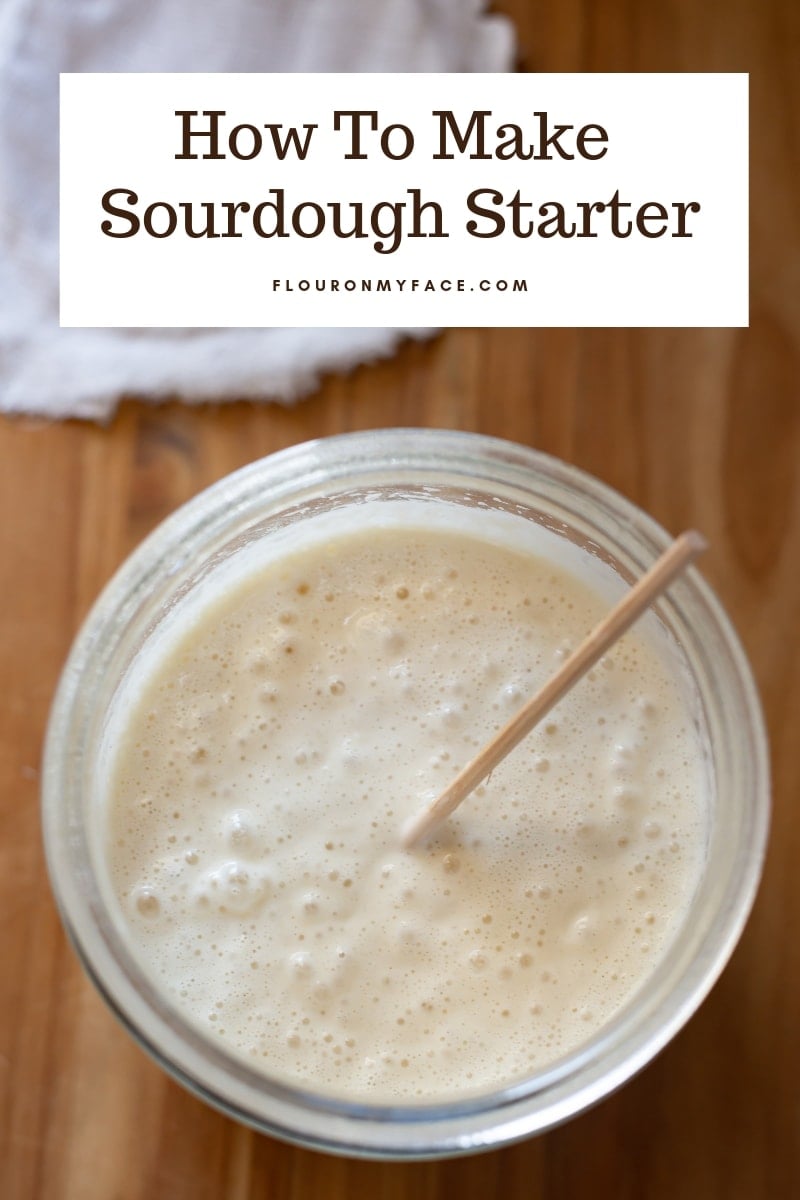
At the time of this writing, my sourdough starter is 2 years old.
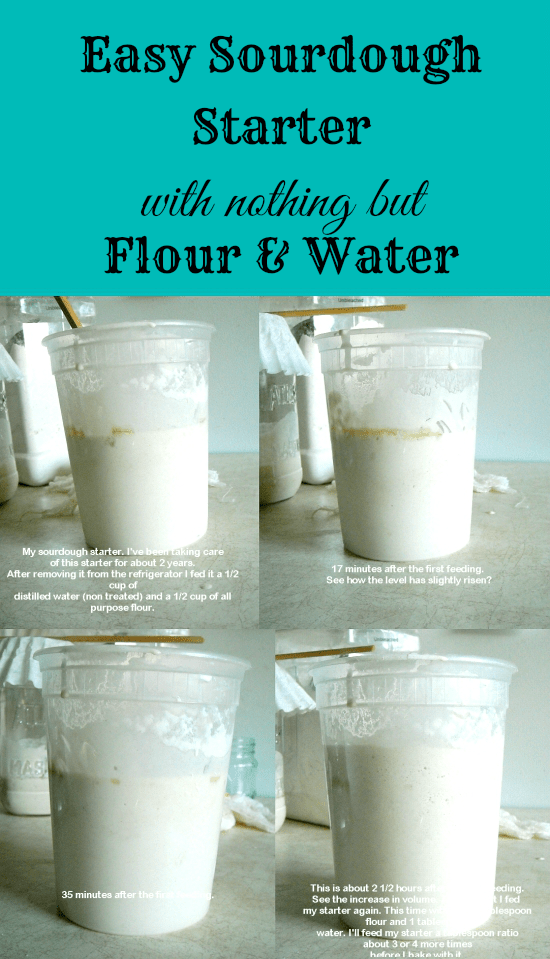
Sourdough Starter
I set out to write this blog post on making a sourdough starter about three weeks ago. I sent out a tweet mentioning sourdough starter. Some of my twitter followers responded.
They were very interested in learning how to make a starter. I wasn't surprised. Sourdough bread is very popular. Some people have great success. Others do not.
Sourdough baking can be a lot of trial and error.
To start with some people never get past getting a decent sourdough starter going.
Others have no problem at all. They get their starter going and they bake perfectly risen sourdough bread.
Then they post beautiful pictures of those perfect loaves and along comes someone like me or even you.
You and I want to bake some of those perfectly risen, beautifully formed loaves of bread also.
But our first attempt at a starter is a total failure. Maybe you or I try again. I know I did. It actually took me 3 or 4 attempts to get my sourdough starter going.
If it happened to me I figured it probably happened to plenty of you also.
So I decided to just give you the how-to version of starting a sourdough starter.
So here we go. I wish you luck in your sourdough starter adventure should you decided to take it.
FREE Sourdough Starter Feeding Tracker
For enthusiasts eager to delve into the world of sourdough breads, keeping a sourdough starter alive and active is fundamental.
To help maintain your starter's health and track its feeding schedule, our FREE Sourdough Starter Feeding Tracker is an essential tool.
How to Make Sourdough Starter
What you will need:
There are only three things that you will need to grow your own sourdough starter.
- Flour
- Water, distilled or untreated
- Patience
The first two ingredients are fairly easy to come by.
The third is a little harder to have but it will only take 3 days to get a sourdough starter going.
Once it is going you're good to go. It will live for a very long time as long as you occasionally feed it. Whether you're going to be baking with it or not it will need to be fed at least once a month.
I bake with mine about once a month. The rest of the time it lives in the refrigerator. Sometimes I pull the container out and give it a feeding. Other times I only feed it right before I plan to bake with it.
I've gone a month or two without a feeding and it always comes back to life the minute I stir a bit of flour and water in. Sourdough starter is very forgiving.
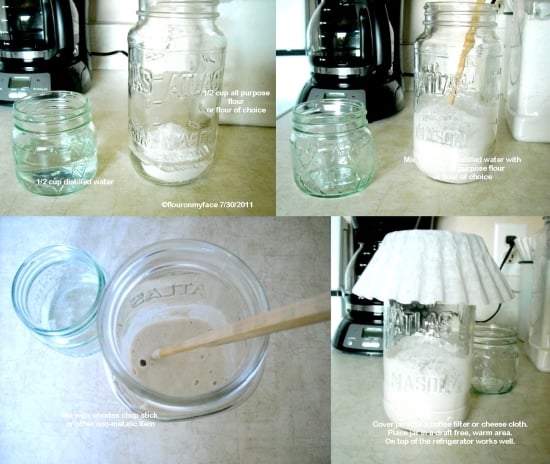
Sourdough Starter Day One
Photo 1 & 2: Add a ½ cup of distilled or non-chlorinated water to a ½ cup of flour.
Photo 3: Stir with a wooden chopstick or other non-metallic items.
Photo 4: Cover the jar with a coffee filter or a piece of cheesecloth. You do not want to cover your starter with an airtight cover. You may also leave it uncovered all day then cover it overnight.
Keep your container in a warm area of your home. You don't want cool air from an air conditioner duct to blowing down on it. You can put it on top of a warm appliance like the refrigerator.
Sourdough Starter Day Two
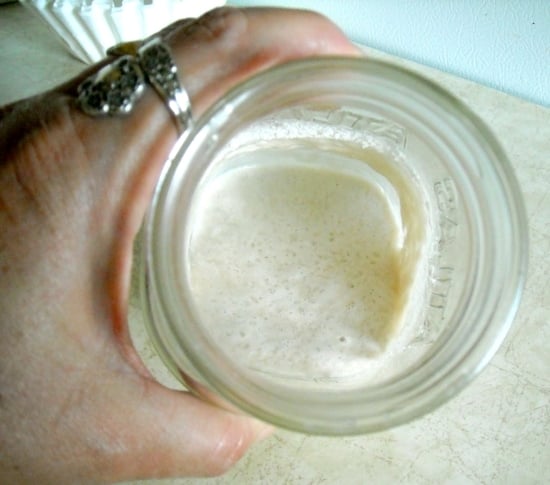
First thing in the morning feed your starter 1 tablespoon of flour and 1 tablespoon of water. 4 or 5 times throughout the day feed your starter with the tablespoon ratio.
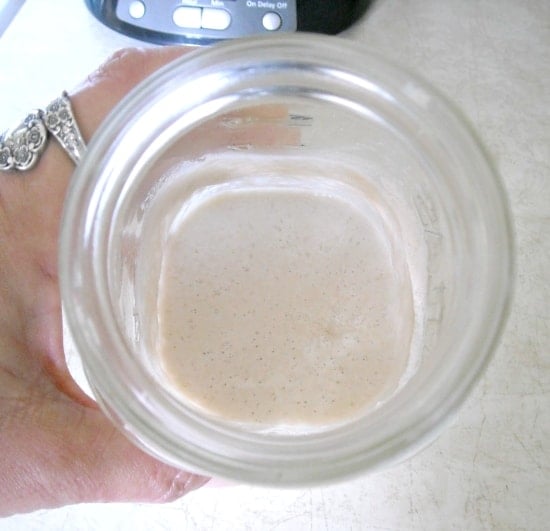
This is about 2 hours after the first feeding on the 2nd day. See the bubbles forming? Already this sourdough starter is living and breathing.
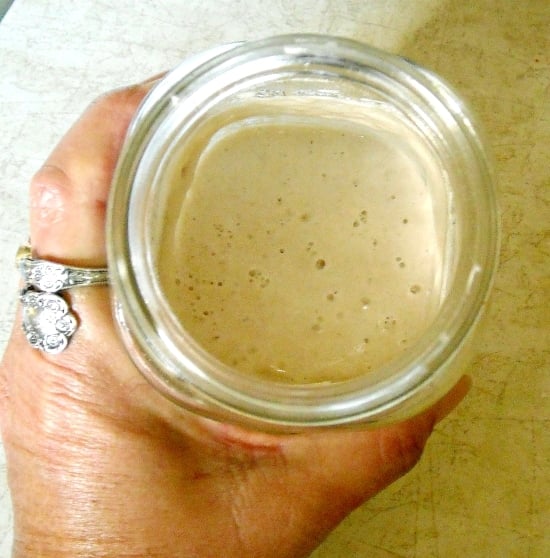
Sourdough Starter Day 3
Feed it ¼ or ⅓ cup of flour and the same amount of water so you have a good amount of sourdough.
Most sourdough recipes call for 1 - 2 cups of starter. You want to have some starter left over.
On the third day continue to feed it throughout the day. If you plan to bake with your sourdough starter right away increase the amount of flour per feeding so you will have about 2 cups of starter.
After using the amount for your recipe feed the remaining starter ½ cup of flour and a ½ cup of water to start building the amount of starter back up.
You can put it in the refrigerator about an hour after that feeding.
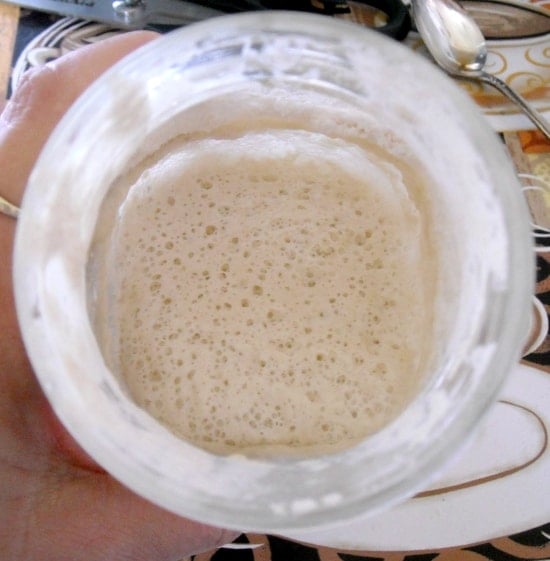
Three days of feeding a new sourdough starter. Sourdough starter success!
The type of flour you use will make a difference in how fast your starter develops.
I was using King Arthur unbleached all-purpose flour.
If you're using a rye or whole wheat flour your starter may look different and will smell different then a starter using all-purpose flour.
If a layer of liquid develops overnight in your container of starter this is what's know as hooch. Some people stir it in but I pour it off. It doesn't matter either way.
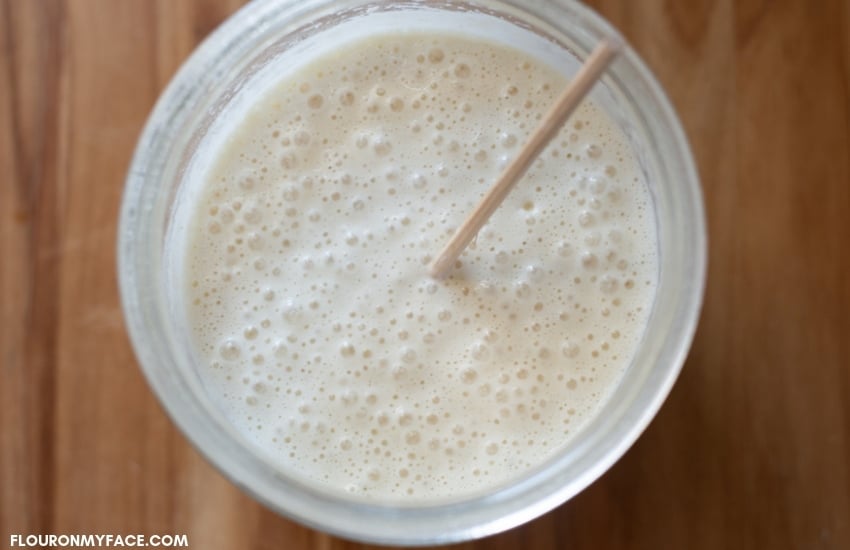
Sourdough Starter Recipes
One of my favorite recipes to use with my starter is a recipe for a Sourdough Focaccia I found a few years ago.
It is so good that I will forever keep a batch of starter going just so I can bake this focaccia.
Another great sourdough recipe is this recipe for Sourdough Waffles from King Arthur
Helpful Sourdough Starter Tools
Using the right tools is just as important as using the right ingredients. Make sure your recipes turn out perfect every time.
Print the How To Make Sourdough Starter recipe below

Email questions or recipe requests to flouronmyface@gmail.com. Follow me on Pinterest, YouTube, Instagram and Facebook.
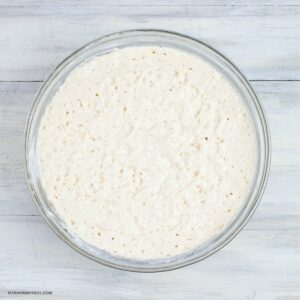
How to Make A Sourdough Starter
Ingredients
- 2 cups all-purpose flour (divided)
- 2 cups unchlorinated water
Instructions
How To Make Sourdough Starter Day One
- In a clean glass jar place ½ cup of all-purpose flour.
- Pour ½ cup of room temperature unchlorinated water into the jar.
- Stir until combined with a plastic or wooden chopstick.
- Place the coffee filter over the top and secure with a rubber band. Place the jar in a warm spot away from cold air.
- After 4 hours remove the coffee filter and add 2 tablespoons of flour and 1 or 2 tablespoons of water. Add just enough water so you can stir the mixture well.
- Repeat adding the 2 tablespoons of flour and water one more time before going to bed.
How To Make Sourdough Starter Day Two
- In the morning add 2 more tablespoons of flour and enough water to stir well.
- Repeat this step three or four times over the course of day two.
How To Make Sourdough Starter Day Three to Day Seven
- Repeat adding 2 tablespoons of flour and water for the next two days. By the third or fourth day you might see a small amount of liquid form on the top. This is called houch. You can mix the houch in or carefully pour it off.
- You will also begin to see foamy bubbles form on the top of the sourdough starter. Congratulations your sourdough starter is coming to life.
- But wait. Your sourdough starter is not active enough to bake with just yet. Continue to feed the sourdough starter for another 2 to 3 days. You can increase the amount of flour and water ratio if you are in a hurry to bake. The more bubbles you see the more active your sourdough starter is becoming.
- The warmer you keep your growing sourdough starter the faster it will become active.
- Once you see a large number of active bubbles form on the top and in the sourdough starter you can bake. It can take from 3 days to 7 days to grow an active sourdough starter.
How To Store Sourdough Starter
- Once you have an active sourdough starter you can keep it in the refrigerator when you are not baking. Keep a clean coffee filter or piece of cheesecloth over the top of the jar and place it in the refrigerator.
- You can also keep your starter on the counter in a safe place. Keep it covered and feed it once a week.
How To Feed and Activate a Refrigerated Sourdough Starter
- While your starter is in the refrigerator it will go dormant. You can easily bring it back to life by taking the sourdough starter out of the refrigerator and begin feeding it before you plan to bake.
- Feed a refrigerated sourdough starter at least once a month. Take it out of the refrigerator and feed it once or twice throughout the day. Once it shows active bubble return it to the refrigerator.
- Sourdough starter can last years as long as you keep feeding it occasionally.
Baking with a Refrigerated Sourdough Starter
- To bake with a refrigerated sourdough starter take the jar of inactive sourdough starter out of the refrigerator 24 to 48 hours before baking. Begin feeding the dormant sourdough starter 3 or 4 times in a 24 hour period to reactivate it.
- Do not feed the sourdough starter right before using it. Feed it for the last time the night before you plan to bake. A newly fed sourdough starter will need at least 4 hours but can take up to 8 hours to become active enough to back with. The more active and alive to sourdough starter is the less time that can take.
Video
Recipe Expert Tips
Other Supplies Needed
- plastic or wooden chopstick
- cheesecloth or paper coffee filter
- rubberband
How To Make Sourdough Starter Tips
- If you are in a hurry to bake you may increase the amount of flour and water ration to ¼ a cup of flour for each feeding. You will accumulate a large amount of sourdough starter this way.
- You can transfer the starter to a larger container or just pour off the excess starter when your jar starts to get too full.
- The warmer it is the faster your sourdough starter will become active.
- The first few times you bake with your new sourdough starter you may not get much of a rise. Continue to add flour and water to your starter to keep it alive. The older you sourdough starter is the more active it will become.









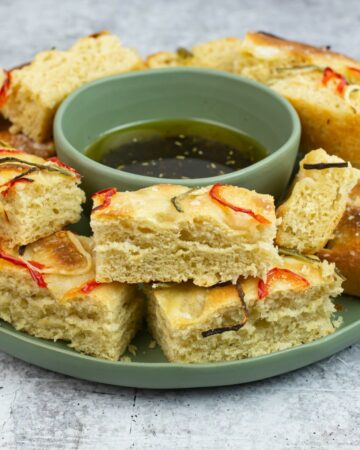
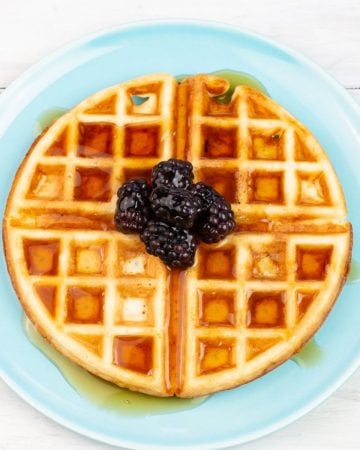

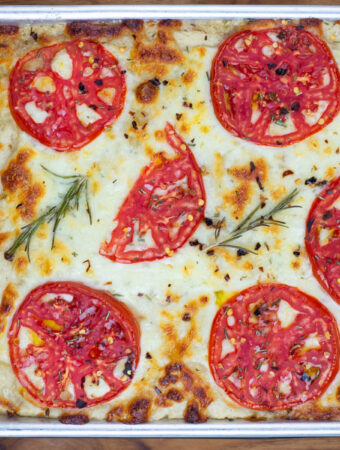
Claudia
Hi Arlene! Thank you for such amazing recipe i always wanted to try the starter but I was confuse about it, ur recipe open my eyes to sourdough bread! I just wanted to ask you, when you keep your starter in yje fridge do you put a lid on the container? Or the coffee filter still? And you mention once in the fridge you feed it only once a month but do you take it out of the fridge the day you plan on using it and feed it for a while before actually use it? Or you can use ot right from the fridge? Thank u so much for sharing! God bless you.
Arlene Mobley
Hi Claudia
You are so welcome! You can store the starter in the fridge with a lid or with a coffee filter over the top and a rubber band to keep it in place. When I plan to use my starter I usually take it out the day before and start feeding it. When I first take it out of the fridge I'll add some water to the jar and stir well than add about a tablespoon of flour. If your jar is full before your first feeding you will need to make room by removing some of the starter. Then every couple of hours I will add a bit of water and a heaping tablespoon of flour. I'll do this all day. I usually give it one last feeding before I go to bed. By morning my starter is nice and active and ready to bake with.
You can actually go longer than a month without a feeding but it will take longer or more feedings to get it good and active again. Happy Sourdough bread baking!
KAO
Great article. I tried to make a starter last fall - did not make it - I made it in mason jar with cheescloth but now I realize that the lid ring I held the cloth on with is metal - may have been the issue?? Anyway, when the stater gets going - how much do you feed at the monthly feeding of the flour / water??
Thanks
Arlene Mobley
KAO
Once it gets going and I need to feed it before I use it I will feed it about 4 times a day adding 2 tablespoons of flour and enough water to that it is easy to stir. You can remove about half the starter before feeding and dump it or start another batch or even feed it a few times and bake with it that day.
Laura
Sourdough starters are called Hermann in Germany. A good way to ensure his survival even during long periods of absence is spreading Hermann generously amongst friends who can then help out with his revival, if need be. Thank you for the wonderful doughtorial!
Arlene Mobley
Laura
Thank you for the great information on starters and Germany. I love to learn about German traditions since 3 sets of my great great grandparents came to the US from Germany. My maiden name is Braun.
Kristin
Hi!
This is a great tutorial, thank you for sharing.
This is my first time attempting sour dough and my starter doesn't seem to look like yours.
I'm on day 3 and there are no bubbles in my starter. I'm using a whole wheat flour though, could that be why?
I plan to make some bread with it tomorrow, so I guess I'll find out then if it's edible. 🙂
Arlene Mobley
Kristin
I have never used whole wheat flour to make a sourdough starter. If your starter does not have any bubbles it may not be strong enough to rise your bread. You could keep feeding it longer. Is it cold in your house? If so put it close to a heat source. On top of the refrigerator would work.
You could also start another batch using all purpose flour. Once it is nice and active you could convert it to a whole wheat starter by feeding it with whole wheat flour. Good luck!
Wendy
I have 3 different starters going now ( I started my first batch back in Jan and did loose 1 to mold firs to of the month so on my 4th one since then) and have found each one works different and the longer it goes the better it gets. I also have tried many different things I have found online. One of mine I started with rye flour and pineapple juice and then after the first week switched to rye flour and water for feedings. My last start I started on April first with wheat flour and water and it was very sourdoughy within 5 days of starting it. Where the first ones I started in Jan took over 2 months to start making breads that had a sourdough taste. I also found were some took longer to really start going up to like 7 days before making my first breads with them. I have also found wheat or rye flours once they really get going make my starters more active than white flour. Oh another trick I found that has helped get them going when slow is covering with cheese clothes and placing in the open kitchen window (on days that aren't to cold) to help catch more natural yeast in the air. I will be whipping up my next loaf of bread tomorrow. I also keep track which starter I use each time so I use them all equally.
Arlene Mobley
Wendy
It sounds like you are a very dedicated sourdough lover. I never could get the pineapple juice trick to work for me. Some people leave their sourdough starter on the counter all the time. I've never done this myself but I bet those starters are really active. Thanks for stopping by. Happy baking!
P.S. if you are on Pinterest you should check out my Sourdough Recipes board. You will never run out of recipes to make using your sourdough starter.
Allison
Found you on Pinterest! Question: once you take it out of the refrigerator and feed it do you leave it out before you use it? Or do you just feed it and make bread?
Arlene Mobley
Hi Allison
If you plan on baking with the starter yes you leave it out. You always want to start with a room temperature starter. Thanks for finding me on Pinterest!
pam
what about using a gluten free four bread....yes or no
If we can is there something else we need to do
Arlene Mobley
Pam
I have never tried making a gluten free starter. I'm not sure how well using a gf flour would work.
Donna Smith
My husband is diabetic and I try to bake with brown rice flour or other flours that have low carb readings. Will the starter develop with them? I know that store bought sour dough bread has a low carb and sugar reading. Help with the diabetic diet.
Arlene Mobley
Donna
I wish I could help but I have never tried making a starter with anything but a regular flour. I'm sure I have seen recipes for gluten free sourdough. I bet if you searched on google or Pinterest you could find a gf sourdough starter to try.
Tara
Thanks for this post! I found it on Pinterest. It is very easy to follow, which I greatly appreciate. 🙂 My only question is...when you put it in the refrigerator, do you still cover it with a coffee filter? (Sorry if I overlooked the answer to his question.)
Arlene Mobley
Tara
Yes I keep the coffee filter on in the refrigerator. But you could cover it with a lid if that works better for you. Either way will work.
Rachael
Just need to confirm, when we feed the starter, do we stir the flour and water in or let it just sit on top?
Arlene Mobley
Rachel mix it in each time you feed.
Kathy
What recipe do you use for the actual sourdough bread ?
Clueless
Michelle
This is awesome! Thank you so much!
Peggy
Great tutorial! When I'm ready to tackle a sourdough, I know where to look =)
Flour On My Face
Lisa
I am sorry to hear about the passing of Herbie, your starter! I would be so sad if I lost mine. I tried the pineapple starter recipe and it never worked for me. I've read about the grape one but never tried it. I'm not sure why the pineapple one didn't work. Plain old flour and water did the trick.
Thanks for stopping by and commenting!
Lisa
I just spoke of my now deceased awesome, SD starter, on my blog, which I had for 3 years. I made it using Nancy Silverton's grape starter method. I neglected 'him', unintentionally, and 'he' couldn't be revived. Think it's time to start a new one, especially with the cooler months coming up 🙂 Bread baking time!
Flour On My Face
Deb
Your welcome! It's not that much of a commitment once you get your starter good and active. If your going to be gone more then a week on vacation I would suggest waiting until you come back.
Deb
Thanks for the step by step tutorial. I have wanted to start-the starter, but wonder if I can be consistent in it's care. It quite a commitment! Perhaps after I return form vacation?